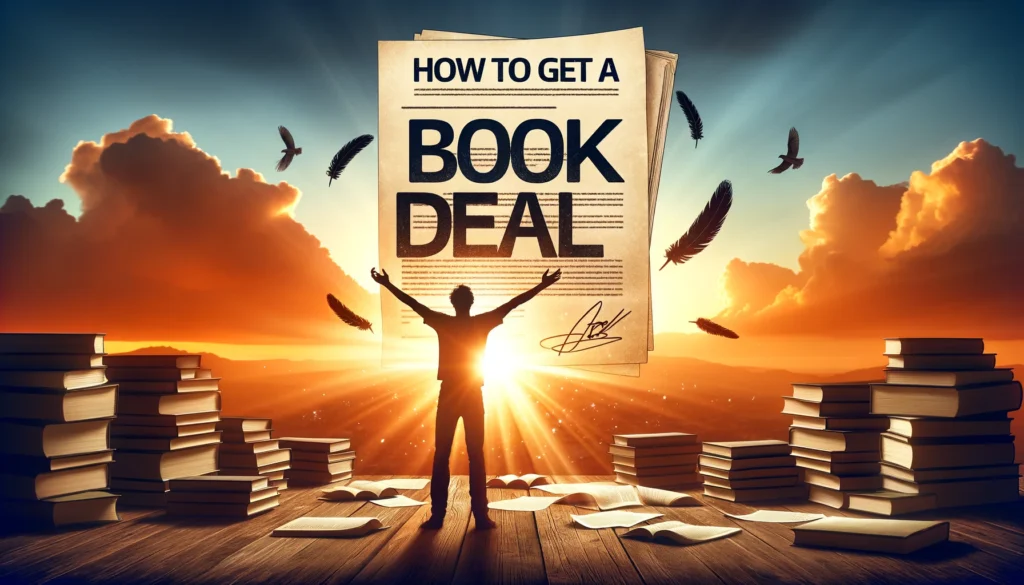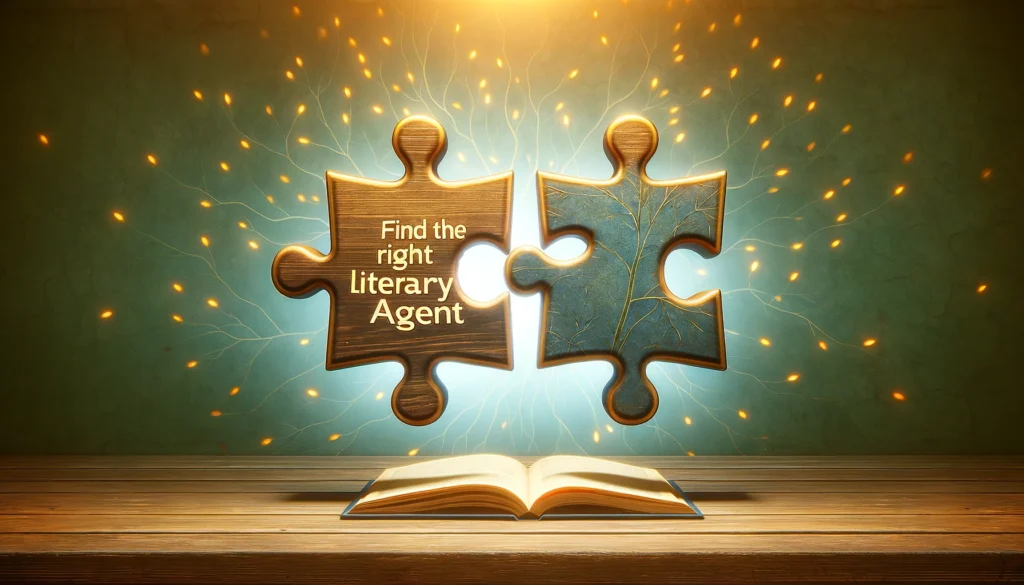Thinking about how to get a book deal? It’s a question many aspiring authors are turning over in their minds as they consider the next steps for their manuscripts. Whether you’ve got a fully drafted novel or just a solid idea, the path to publication might seem way too complicated to handle.
However, it’s a topic worth diving into, especially if you’re serious about seeing your work in print. And that’s exactly what we’re here to do. No fluff, just straight talk about what it takes to catch a publisher’s eye.
We’ll break it down together, step by step, making the process as clear and actionable as possible. From honing your manuscript to landing an agent, consider this your guide through the maze. Let’s get started.
How to Get a Book Deal

Getting a book deal isn’t just about having a fantastic idea. It is also about how you present it, what agent you find, etc. So let’s take a closer look at all the steps you have to take to get a book deal.
1. Write Something Worth Reading

Writing something worth reading is where it all begins, the foundation upon which everything else is built.
You’ve probably heard it a thousand times, but the importance of having a solid, compelling manuscript cannot be overstressed.
Why? Because at the end of the day, no matter how much you know about the market, no matter how many connections you have, if what’s on the page doesn’t capture the reader’s attention, it’s a non-starter.
A compelling manuscript is more than just stringing together sentences that make sense. It’s about infusing your unique voice into every page, weaving a story only you can tell, and sharing insights that provoke thought, evoke emotion, or entertain.
Your voice is your signature, your story is the vehicle, and your insights are the fuel that will keep readers engaged from start to finish.
Think of it this way: every book that’s ever made you miss your stop on the bus or stay up way too late reading under the covers succeeded because the author delivered something worth reading.
They mastered the art of storytelling, found a unique angle, or presented information in a way that resonated deeply with their audience.
So, before you start worrying about agents, publishers, or market trends, focus on the core of your project. Polish your writing, invest in your characters or arguments, and make sure that what you’re putting on the page is something you believe in.
Remember, you’re not just writing to get published; you’re writing to be read.
2. Polish Until It Shines
Once you’ve poured your heart and soul into your manuscript, it’s time to polish until it shines. This stage is critical, a bridge between your raw creation and the polished piece that will captivate readers and catch a publisher’s eye.
Editing isn’t just about fixing typos or correcting grammar; it’s a deep dive into the essence of your work, refining and honing until every sentence, every chapter, aligns perfectly with your vision.
First, take a step back. It’s hard, I know. You’ve been so close to your work for so long, but gaining a bit of distance can give you fresh eyes.
When you return, read through your manuscript as if you’re encountering it for the first time. You’ll be amazed at what jumps out at you—phrases that clunk, dialogue that doesn’t quite sound true, plot lines that meander.
Next, seek feedback. This can be from beta readers, writing groups, or even a professional editor. Choose people who understand your genre and will provide honest, constructive criticism.
Feedback is gold; it uncovers blind spots and opens up new avenues for improvement you might never have considered on your own.
Now, brace yourself for revision. This is where the real work begins. Revising isn’t just about making cuts or tweaks here and there; it’s about seeing your manuscript as a living, evolving entity that you’re sculpting toward its ideal form.
This may mean rewriting entire sections, rethinking characters or arguments, and refining your narrative to make it as tight and compelling as possible.
Finally, remember that perfection is a moving target. Your manuscript may never feel “done” in your eyes, but there comes a point where it’s the best it can be.
This doesn’t mean settling for less than your best; it means recognizing when your efforts have brought your work to its highest potential.
That’s when it’s time to step back and acknowledge that you’ve done everything you can to prepare your manuscript for the world.
Polishing your manuscript is a labor of love, an exercise in patience and persistence. But it’s worth every moment. When your work finally lands on a publisher’s desk, shining in its best light, you’ll know all that effort was not in vain.
3. Understand the Market

Knowing where your book fits in the current market is crucial for positioning it for success.
This doesn’t mean you should chase trends or lose the essence of what makes your book unique. Instead, it’s about recognizing the landscape you’re stepping into and finding the right spot for your work to bloom.
What’s hot and what’s not can fluctuate, but certain genres and themes have lasting appeal, while others see cyclical interest.
Doing a bit of research can help you understand current reader preferences and industry trends. Look at recent bestseller lists, follow what’s being talked about in book clubs and literary blogs, and pay attention to upcoming book fairs and festivals.
All of these can offer clues about the market’s direction.
But where does your book fit in? This is where your unique selling proposition (USP) comes into play.
Your USP is what sets your book apart from others in its genre or category. Maybe it’s your unique voice, a fresh perspective on a familiar theme, or a narrative that weaves together elements from different genres in a way that hasn’t been seen before.
Understanding your USP not only helps you articulate why readers should pick up your book but also assists you in targeting the right agents and publishers who are looking for exactly what you’re offering.
Remember, while it’s important to know the market, don’t lose sight of your vision for your book. The goal isn’t to conform but to find where your unique creation fits within the broader landscape.
In doing so, you’ll be better positioned to find your audience and make a lasting impact.
4. Find the Right Literary Agent

The right literary agent is going to be your advocate, your champion in the publishing world, so it’s crucial to find someone who’s as excited about your book as you are.
Start with Research
Your first step is to compile a list of agents who specialize in your genre. Agents often have specific tastes and preferences, and their portfolios can give you a good idea of the types of books they are passionate about.
Use resources like the Acknowledgments section of books similar to yours (authors often thank their agents here), online directories, and industry listings to create your initial list.
Dig Deeper
Once you have a list, it’s time to dig deeper. Visit the agents’ websites, read their blogs or interviews, and follow them on social media if they’re active.
This will give you insights into their personality, their working style, and, most importantly, their submission guidelines. You want to ensure that your approach is personalized and that you’re adhering to their preferences right from the start.
Be Professional and Patient
Approach agents professionally, treating your query like a job application. Be concise, clear, and compelling in your communication, presenting your book in the best light possible.
After you’ve sent your query, patience is key. Agents receive hundreds of submissions, and it can take time for them to review yours.
Be Open to Feedback
Finally, be open to feedback. If an agent takes the time to respond to your query with advice or constructive criticism, consider it a valuable insight into how you can improve your pitch or manuscript.
Even if the response is a rejection, it might come with nuggets of wisdom you can use as you continue your search.
Remember, finding the right literary agent is a critical step in your publishing journey. This person becomes your partner in navigating the complexities of the publishing world, so it’s worth the effort to find someone who truly connects with your work and vision.
5. Be Prepared for Rejection (and Keep Going)
Let’s have a real talk about rejection because it’s something every writer faces on their path to getting published. It can sting, dishearten, and even make you question your talent. But here’s the thing: rejection is part of the process, not a dead end.
Think of it not as a stop sign but as a detour sign, guiding you to find another route to your destination.
Every “no” you receive is, in fact, a step closer to that coveted “yes.” It’s a bit like sifting through a pile of mismatched puzzle pieces. Each piece that doesn’t fit gets you closer to finding the ones that do, completing the picture you’ve been working so hard to create.
It’s important to remember that rejection isn’t personal. It doesn’t mean your work isn’t good; it just means you haven’t found the right match yet.
Here’s how to handle rejection with grace and resilience:
- Learn from It – If the rejection comes with feedback, take it as a gift. It’s a chance to improve, refine, and strengthen your manuscript or query letter. Not all rejections will come with notes, but when they do, consider them valuable insights from professionals who’ve seen countless manuscripts.
- Keep Improving – Use the experience as an opportunity to revisit your work. Can your opening be more engaging? Is your query letter as compelling as it could be? Sometimes, a fresh round of revisions is all it takes to turn future “nos” into “yeses.”
- Stay Persistent – Persistence is key in the publishing world. For many successful authors, the difference between being published and being overlooked was simply not giving up. Keep sending out those queries, keep refining your manuscript, and most importantly, keep believing in your story.
- Remember Why You Write – When the rejections pile up, and doubt creeps in, remind yourself why you started writing in the first place. It’s not just about getting published; it’s about telling stories that matter to you, exploring ideas that fascinate you, and sharing your unique perspective with the world.
Rejection is tough, but it’s also a rite of passage for writers. Each “no” teaches you something valuable, making you not only a better writer but also a more resilient person. So, take a deep breath, dust yourself off, and keep going. Your “yes” is out there, waiting for you to find it.
6. Nail the Book Proposal

Nailing the book proposal is crucial, especially with traditional publishers. Here’s how to make yours stand out:
- Define Your Book’s Purpose – Start with a clear, compelling statement about what your book is and why it needs to exist. What gap does it fill? What new perspective or information does it offer?
- Know Your Audience – Demonstrate that you know exactly who your book is for. Define your target audience with as much detail as possible. Who are they? What interests them? Why will they find your book irresistible? Showing that you understand your audience helps publishers see the market potential of your book.
- Showcase Your Authority – Why are you the right person to write this book? Highlight your credentials, experience, and any unique insights or access you have to your topic. This isn’t about boasting; it’s about establishing credibility and trust with your readers and the publisher.
- Provide Sample Chapters – Select one or two chapters to include in your proposal as samples of your writing. Choose sections that best showcase the compelling nature of your topic. These samples are your chance to prove you can deliver.
- Marketing and Promotion Plan – Publishers want to know that you’re ready to be a partner in the success of your book. Outline your plans for marketing and promotion, leveraging your platforms, connections, and any strategies you have for reaching your audience and boosting sales.
7. Understand the Business Side
After you clinch that book deal, you’re on your way from writer to author, a journey that’s exciting but also packed with new responsibilities, particularly around the business side of things.
First up, understanding your contract is key. This isn’t just any document. It outlines your royalties, advances, and rights.
Getting a grasp on these terms ensures you know exactly what you’re getting into and what you can expect in terms of earnings.
Speaking of earnings, let’s talk about advances and royalties. An advance is essentially a publisher’s bet on your book’s success, paid out to you before the book hits the market.
Royalties, on the other hand, are your cut from the book’s sales, kicking in after your advance is “earned out.” The specifics here can vary widely, so it’s important to get clear on the details from the start.
Now, about making your book the best it can be: editing. Once you’ve signed with a publisher, your manuscript will go through further rounds of edits.
This is all about refinement and making sure your book resonates with your intended audience. It’s a collaborative effort with your publishing team to polish your work until it shines.
And let’s not forget about copyright. Copyrighting your book is an essential step in safeguarding your creative work. It’s automatically in place from the moment your work is created and fixed in a tangible form.
However, understanding how copyright protects your rights and what it means for your book is an important aspect of the business side of being an author.
Conclusion
Diving into the process of how to get a book deal reveals a journey that’s both challenging and rewarding. It requires dedication, resilience, and a willingness to learn and adapt. Remember, each step, from crafting a compelling manuscript to understanding the market, finding an agent, and navigating the publishing business, plays a crucial role in turning your dream into a reality.
Ultimately, securing a book deal is about more than just writing; it’s about positioning yourself and your work in a way that attracts attention in the crowded publishing landscape. Stay focused, stay persistent, and keep refining your craft. Your passion and perseverance are your best allies on this journey.
FAQ
How much money do you get for a book deal?
The amount of money you get from a book deal can vary widely based on factors like the genre, the market’s current trends, and the publisher. Advances can range from a few thousand dollars for new authors to six or even seven figures for established authors with a proven track record. Royalties, paid as a percentage of book sales, are also a key factor in an author’s earnings.
How many followers do you need to get a book deal?
There’s no set number of followers required to get a book deal. While a strong social media presence can demonstrate your ability to market yourself and your book, publishers primarily focus on the quality of your manuscript and its market potential. However, having an engaged audience can certainly be advantageous.
How do I get an agent for a book deal?
Getting an agent involves researching agents who represent books similar to yours, crafting a compelling query letter that pitches your book, and submitting it according to the agent’s submission guidelines. Persistence is key, as finding the right agent can take time and may involve facing rejections.
How quickly can you get a book deal?
The timeline to get a book deal varies greatly. After finishing your manuscript, finding an agent can take several months to a year (or more), and securing a deal with a publisher can add additional time. The entire process from manuscript completion to book deal can span anywhere from a few months to several years.
How to get a book deal without an agent?
Getting a book deal without an agent is challenging but possible, especially with smaller publishers or if you’re considering self-publishing. You can submit your manuscript directly to publishers that accept unsolicited submissions, ensuring your pitch and manuscript align with their submission guidelines.
How much is a book deal worth?
A book deal’s worth varies, encompassing the advance, which is paid upfront, and royalties, which are earned over time based on book sales. Advances for first-time authors typically range from $5,000 to $15,000, but this can significantly vary based on the book’s perceived potential and the publisher’s size.
Average book deal for a first-time author?
The average book deal for a first-time author typically includes an advance of $5,000 to $15,000, although this can vary widely based on the genre, market, and publisher. Royalties—which are a percentage of the sales—are then paid after the advance is “earned out” through book sales.
